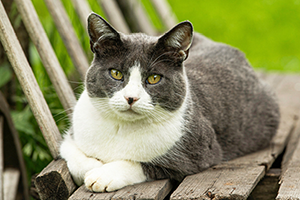If your cat is overweight or your vet suggests they could benefit from losing a few centimetres from their waistline, it’s important to monitor what they’re eating.
UK Pet Food recommends feeding to your cat’s ideal weight, not their actual bodyweight. Check the feeding guide on your cat’s food (you’ll also be able to find more information on how much you should be feeding your cat on the manufacturer’s website) – but remember to subtract any other sources of food on offer.
Petplan veterinary expert, Brian Faulkner, recommends ‘weighing out the recommended amount of food in the morning, as opposed to ad lib feeding, which helps to avoid over-feeding throughout the day. Many pet owners guess the recommended volume of food and it’s easy to be 10% over – which often means 10% more body fat for your pet.’
If you have more than one cat, make sure to feed them in separate rooms, so you can keep track of how much each cat is eating. You could even try putting an obese cat’s food bowl at the top of the stairs to encourage them to climb and use more calories.
It’s also important to stick to regular feeding times. Cats are natural snackers, and given the choice, they’ll keep returning to their bowl all day long. While cats should only take in what they need, modern pet foods are so tasty that cats can often overeat. Leave out the right amount at recommended intervals throughout the day to avoid this.
Finally, be sure to use treats sparingly. Avoid processed versions that can be high in calories, opting instead for natural alternatives such as a small piece of plain chicken breast.
Cat owners should also be aware that ‘maintenance’ or ‘light’ cat foods on the market aren’t the same as a veterinary-approved, calorie-controlled diet formulation. As the word maintenance implies, these are more about keeping things the same, rather than actively losing weight.





















